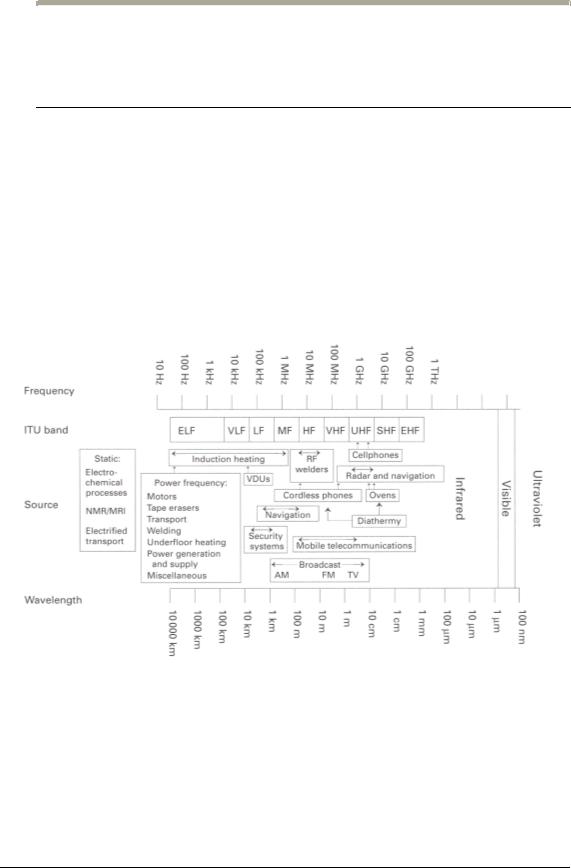
- •Preface
- •Contents
- •1. Introduction
- •2. Sources
- •3. Radiofrequency radiation
- •3.1. Electromagnetic radiation
- •3.2. Quantities and units of exposure
- •4. Exposure and energy absorption
- •5. Radiofrequency biological effects
- •5.1. Whole-body response
- •5.2. Localized responses
- •5.2.1. Reproductive system
- •5.2.2. Teratogenic effects
- •5.2.3. Effects on the eye
- •5.2.4. RF burns and operator hand numbness
- •5.2.5. Carcinogenesis
- •5.3. Conclusion
- •6. Occupational exposure standards and guidelines
- •6.1. ICNIRP guidelines
- •7. Exposure assessment
- •7.1. Measurement of RF fields
- •7.2. Measurement of induced currents
- •8. Control technology and radiation protection programme
- •8.1. General obligations and duties
- •8.1.1. Role of competent authorities
- •8.1.2. Responsibility of the employer
- •8.1.3. Duties of the worker (user)
- •8.1.4. Responsibility of manufacturers
- •8.2. Work practice controls
- •8.2.1. Maintenance procedures
- •8.2.2. Operator procedures
- •8.2.3. Identification of RF hazard areas
- •8.3. Design and installation considerations
- •8.3.1. Shielding
- •8.3.2. Installation details
- •8.3.2.1. Installations near pipes
- •8.3.2.2. Grounding
- •8.4. Medical surveillance
- •8.4.1 Normal conditions
- •8.4.2 Abnormal conditions
- •1. Basic principles
- •Current paths
- •Resistance
- •2. Shielding design and construction
- •Characteristics and selection of shielding materials
- •Joints
- •Ports or slot openings in shielding
- •Doors and removable panels
- •Vestibules (shielding tunnels)
- •High frequency power connections
- •3. Summary of control technology
- •Capacitors
- •Inductors
- •Resonant conductors
- •Waveguides
- •References

3
Radiofrequency radiation
3.1. Electromagnetic radiation
Electromagnetic radiation (EMR) is the emission of energy in the form of waves transmitted through space as time varying or oscillating electric and magnetic fields. Figure 2 shows the electromagnetic spectrum, with the frequency and location in the spectrum of radiation and field, and typical applications. Radiofrequency radiation is a subset of the electromagnetic spectrum ranging in frequency from 100 kHz to 300 GHz. RF radiation is also often referred to as non-ionizing radiation, although non-ionizing radiation also includes, for example, the infrared and visible spectrums.
Figure 2. The electromagnetic spectrum
The wavelength is the distance between corresponding points of successive waves and the frequency is the number of waves that pass a given point in 1 second. The quantities are related and determine the characteristics of electromagnetic radiation: the shorter the wavelength, the higher the frequency. At a given frequency, the wavelength depends on the velocity of propagation and therefore will also depend on the properties of the medium through which the radiation passes. The wavelength normally quoted is that in a vacuum or air, the difference being insignificant. The linking parameter with
4

Radiofrequency radiation
frequency is the velocity of light (3 × 108 m/second in air). This relation can be expressed as:
λ = c/ƒ
where: λ = wavelength c = speed of light ƒ = frequency.
For example, at 27 MHz the wavelength is 11.1 m.
Electric fields emanate from electric charges and voltages on conductors. Convention dictates that electric fields originate on positive charges and terminate on negative charges. Magnetic fields are generated by moving charges (currents flowing in conducting objects) and encircle the moving charge. The operation of RF heaters will generate both electric and magnetic fields. These primary fields are not technically radiation but are reactive near fields (see EHC 137 for a more complete description of near fields and radiating fields around antennas – UNEP, IRPA and WHO, 1993). However, energy can be coupled from these fields just as energy is coupled from the primary to the secondary winding of a transformer without radiation. These reactive near fields can, in turn, generate radiating fields.
RF heaters are not good antennas because the dimensions of the heater are normally small compared to the wavelength of operation (e.g. 11.1 m at 27 MHz). Therefore, RF heater operators are exposed to the reactive electric and magnetic fields.
Power from RF heaters is generated as a continuous wave (CW) at essentially a single frequency although during the processing cycle the frequency of older machines may change significantly. The electric and magnetic fields oscillate as sine waves and may be amplitude modulated at the power supply frequency.
For any particular RF heater application requiring preparation of the material to be processed, the machine is energized for only part of the total production period. This results in a machine duty factor which is the quotient of the period that the RF power is applied to the total period of a typical operational cycle. The duty factor, Dƒ, of a machine is given by:
|
|
Dƒ = Te / (Te + To) |
where: |
Te |
is the period that the machine is energized |
and: |
To |
is the period that the machine is off. |
If the machine is energized for 5 seconds followed by a 45-second period with the power off, the duty factor is 5/50 = 0.1. In assessing operator exposure in terms of energy absorption rate (see section 4), the square of the measured electric and magnetic field strengths or the square of the measured induced body current would be multiplied by the duty factor subject to the overriding time averaging restrictions of the exposure guideline.
3.2. Quantities and units of exposure
Electromagnetic radiation has two field components: the electric (E) field and the magnetic (H) field. The unit of the electric field strength is the volt per metre (V/m), and
5

Safety in the use of RF heaters and sealers
the unit of magnetic field strength is the ampere per metre (A/m). The magnetic flux density (B) is related to the magnetic field strength by:
B = µH
where µ is the permeability of the medium. The unit of magnetic flux density is the Tesla (T). In non-magnetic materials, which include the human body, µ has the value of 4π × 10-7 T/(A/m).
At distances greater than a wavelength from the source, the E- and H-field's have a fixed relationship given by:
E/H = Zo
where: E = electric field strength (V/m) H = magnetic field strength (A/m)
Zo = impedance of free space, 377 ohms.
This region is called the far field or radiation field and the power density (S) or energy flow per unit time through a unit area is determined from the following:
S (W/m²=) = E²/377 = H²/377.
While power density is often used as the quantity for assessing exposure in the far field, operators of RF heaters are exposed in the near field.
The term near field is used to describe the region that is close to the radiation source, generally less than one wavelength. Operator exposures occur well within one wavelength of RF heaters. Thus, heater operators receive near-field exposures. In this region the relative amplitude and direction between the E-field and the H-field varies with location. Thus a simple measurement of E or H will not determine the power density nor assess the potential hazard. Since the body can couple energy from either of these reactive fields, both E and H must be measured to assess the hazard. Due to the rapid variations of both the electric and magnetic field within the near field zone, the E- and H-fields must be measured carefully at a number of points in close proximity to the source.
Power density should not be measured to evaluate heater operator exposures. It is not technically correct to use the term power density to describe radiofrequency radiation in the near field of a device. As a result of exposure to fields from RF heaters, currents are induced in the bodies of operators, and measurements of induced currents is a particularly meaningful way of assessing compliance with exposure guidelines. Therefore, a complete assessment of the exposure would be to measure induced currents, as well as electric and magnetic field strengths.
6
